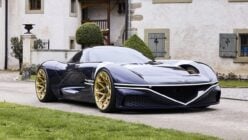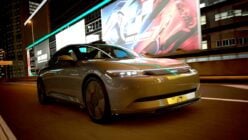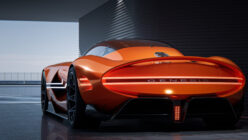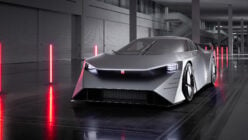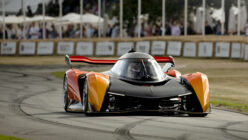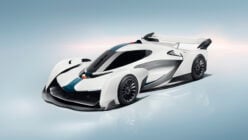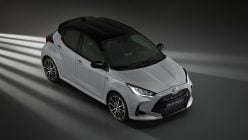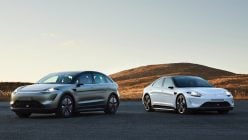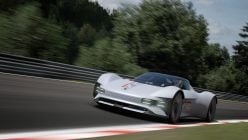The Los Angeles Auto Show is underway and the debuts are coming fast and furious. From bland and boring to awesome and appealing, there’s something for everyone on the show’s floor.
To help you keep track of all the interesting vehicles — and some not so interesting — we thought we’d do a roundup to get you up to speed.

2018 Jeep Wrangler
Our highlight of the show is the long-awaited 2018 Jeep Wrangler.
Riding on a brand new JL platform, the off-roader still bears a striking resemblance to the outgoing JK model. However, even if the new Wrangler looks like the old Wrangler, Jeep assures folks it’s entirely new.
Back in 2015 rumors flew all over the web saying the Wrangler would be a unibody, could be a hybrid, and that the doors and top would no longer be removable. Well, we’re happy to say those rumors were wrong — well sort of wrong.
The new Wrangler still rides on a frame like its ancestors. While unibody vehicles are the norm in today’s world, a body on frame vehicle just does better once you leave the pavement. Getting a unibody would’ve probably cost the Wrangler some of its Trail Rated-ness.
The doors and top are still removable. They even get a bit of an upgrade over previous models too. There is now an optional power canvas roof that allows you to remove it with a push of a button. The doors also get handles for easier removability, which seem like it should’ve been an option all along.
Another cool feature Jeep built into its bread and butter vehicle is an easily removable windshield. In a matter of minutes, you can either fold down the front windshield or completely remove it. According to Jeep, the JK model used to take upwards of two hours to achieve the same results.
Finally, even though the rumors indicated the Wrangler might be a hybrid, we can confirm that there’s only a mild hybrid option. The 2.0-liter four pot gets electric assist with brake regeneration and stop-start technology.
The Wrangler will hit showrooms next year and will be sold alongside the outgoing JK model.

BMW i8 Roadster
In what might be the best looking debut of the LA Auto Show, BMW showed off its i8 Roadster.
When the i8 coupe went on sale in 2014, many in the industry wondered where the drop-top version was. After all when the i8 was in its concept phase, BMW did show off an i8 Spyder concept at Auto China 2012.
With it’s futuristic looking styling, the Roadster shares the same overall shape as the coupe. However, there is one key difference with the convertible. To house the roof when retracted, the rear seats are now absent and instead, there’s a little cubby in which the roof stows itself. We doubt anyone will miss them though since the rear seats in the coupe were pretty much made for people without legs.
The Roadster gets the same plug-in hybrid drivetrain the coupe gets. However, there are some upgrades new for 2019 that will find their way into both cars. The 1.5-liter turbo three gets an update to run a little more green with lower emissions. Even with being more eco-friendly, the car will still make the sprint to 60mph in 4.2 seconds.
The battery pack gets an overhaul too. Battery capacity is up from 24Ah to 36Ah and the gross energy output gets bumped to 11.6 kWh from 7.6 kWh. In gearhead terms, this means the electric motors now produce 141 hp and can push the car to 65 mph without the aid of the engine. The i8 can also now go 18 miles on full electric power.
While this isn’t a Prius by any means, it’s still a very eco-friendly car. It’s nice to see automakers continue to give us these green sports cars. It shows that while the fuel used changes, the fun doesn’t have to.
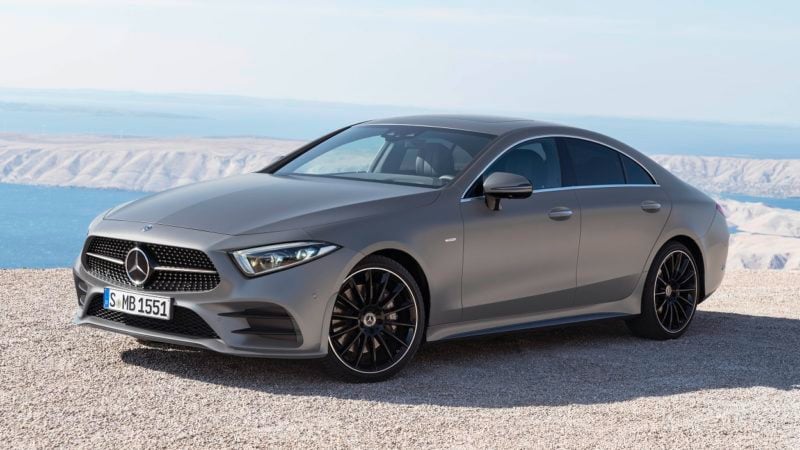
2019 Mercedes-Benz CLS
While the BMW i8 Roadster is the best looker, the new Mercedes-Benz CLS is right up there with it in terms of a handsome design. Well, at least from some angles…
With its coupe roofline and high belt like the CLS still manages to stand out slightly in the sea of German cars. However, when compared to the previous generation the 2019 model brings a tidier look.
Perhaps the best thing about the new CLS is the engine. This is the first Mercedes model to use its new 3.0-liter inline-six. With 362hp and 396lb-ft of torque on tap, the CLS is sure to make the most of any Autobahn cruise, even if the top speed is just 130mph.
The CLS will also use a 48-volt mild hybrid system to help with fuel economy. Mercedes didn’t release the figures but we’d expect it to be right around 30mpg (US) combined.
The Merc will go on sale starting in the fall of 2018. A special Edition 1 model, sporting matte gray paint, will be part of the initial release.

Saleen 1
Saleen is returning to the market eight years after the end of the S7 production. Its car this time is a bit different this time around though.
No more is it a big Ford V8 monster with twin turbos, spitting out a whopping 750hp. Instead, the Saleen 1 gets a fairly modest 2.5-liter turbo four, that Saleen built from the ground up. It produces roughly 450hp and 350lb-ft of torque, which is more than enough for its small, lightweight construction. According to Saleen, the car should rocket to 60 in just 3.5 seconds.
Another big change for the brand is its country of origin. No more is it the homegrown supercar from Irvine, California. Instead, Steve Saleen teamed up with a Chinese company known as Jiangsu Saleen Automotive Technology Group. Jiangsu will provide the capital for the project and do all of the assemblies for the car at a plant in China.
We still don’t have many details regarding the car, but we are looking forward to the Saleen 1. Even if it isn’t the American supercar we’ve come to admire, it still should be a fairly respectable sports car. Time will tell though if Americans buy into the Made in China label.
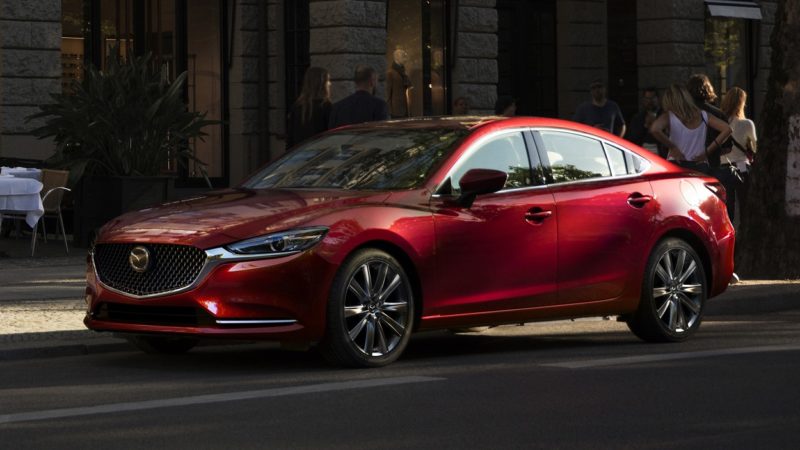
2018 Mazda 6
The much-loved Mazda family sedan gets a much-needed upgrade. The previous generations were excellent cars that drove incredibly well. However, they lacked power compared to their rivals. The new Mazda 6 changes all that though.
The current Mazda 6 comes with a rather lackluster 2.5-liter straight four sporting just 184hp. That wasn’t enough for the car to get out of its own way. Apparently, Mazda thought the same thing and did something about it.
With the 2018 model, you can now get a turbo on that 2.5-liter engine. The results? 250 hp and 310 lb-ft of torque. While it’s not as powerful as the 3.5-liter V6 Toyota Camry, it still trounces most other I4 family sedans.
To the dismay of the “Save the Manuals” crowd you can’t get the 2.5-liter turbo with a six-speed manual. However, you can still get the base non-turbo 2.5-liter car with a stick. Manual lovers can rejoice a little bit here since it’s not completely dead.
On the outside, the 6 gets a refresh to bring it more in line with the new Mazda corporate face. Thankfully, the corporate design from Mazda is still pretty handsome so the Mazda 6 comes away looking rather good as a result.
The 2018 Mazda 6 will head to showrooms in early spring. The base price will start at just $21,995 and go up from there. However, no matter what the premium is on the turbo engine, it’ll be worth it for sure.

2019 Lincoln Nautilus
With all the companies out there continuing to take their model names and make them more confusing, Lincoln is doing the opposite. No more will you need to remember the alphabet soup that comes with a Lincoln vehicle. From now on they’ll all start getting actual names.
The reason behind the name change is primarily China, which is a strong market for Ford to sell the Lincoln brand in. It seems that the letters just didn’t translate well outside of the English language. The hope is that buyers will end up less confused over which vehicle they purchased.
The Nautilus is still very much a Ford Edge, just with a new suit. Lincoln has swapped the aging 3.7-liter V6 for a new 2.0-liter Ecoboost I4. The 2.7-liter Ecoboost V6 still remains as the top-of-the-line engine though and is good for 335hp and 380lb-ft of torque.
The Nautilus is neither fast nor as luxurious as its German rivals, but it does fit the American — and apparently Chinese — market nicely.
It’ll head out to dealers in the spring of 2018.

Hyundai Kona
The compact SUV market is one of the fastest growing markets in the US today. This is why it’s not surprising Hyundai threw its hat into the ring to turn up the heat on the competition.
With styling that took the worst bits of every forward-thinking design — see the Nissan Juke and Jeep Cherokee — the Kona embraces its funky, modern look. However, it looks incredibly busy compared to some other compact SUVs on the market today and it’s unknown how buyers will react. The Juke was recently sent to pasture and the Cherokee got a facelift to make it look less homely. Time will tell if Hyundai can do the weird fascia look in a way to attract buyers.
It shares its underpinnings with the Kia Rio. However, it gets a much better engine selection than the Rio does. The Kona will come with a choice of either a naturally-aspirated 2.0-liter snooze fest or a fairly interesting 1.6-liter turbo. The 1.6-liter is good for 175hp and 178lb-ft of torque, which should make the Kona fun to drive.
The optional kit for the Kona has all the bells and whistle you’d expect from a car targeting the market for active young people. LTE connectivity, Apple CarPlay, Android Auto, wireless phone charging, and an eight-inch touchscreen all come as optional extras. You also get things like blind spot monitoring, active high-beams, and pedestrian detection as options as well.
The Kona will also come in a wide variety of extrovert colors as Hyundai describes it. These will be loud and bright, because apparently that’s all young people want.
You can expect the Kona to hit showrooms early next year with a starting price right around the $20,000 mark.

Nissan Kicks
The Juke is dead. With its love-it or hate-it design the Juke just didn’t sell well enough to keep around. Its replacement? The Kicks.
There’s no easy way to say this so we will just put it out there. On paper, the Kicks looks atrocious. With a 1.6-liter four pot good for just 125hp and 115lb-ft of torque, it already seems massively underpowered. It also lacks a key ingredient to the compact crossover market, AWD. That’s right, you get a tiny crossover with a meager engine and just FWD.
We aren’t sure who the target demographic is for the Kicks, but much like the Kona, we assume it’s for active young people. However, active young people typically like things like a turbo and AWD. They also like vehicles with character, something the Kicks has none of with its bland styling that looks right at home in the airport rental car lot.
While the Juke was odd looking, you at least could have it with a turbo and AWD. It would also sprint to 60 in under nine seconds and could be fairly fun to drive with the right trim. None of which seems to be the case with its replacement and that’s actually kind of sad.
Hopefully, a Nismo version is in the works somewhere that will at least put this car where it should be from the factory. Failing that, Nissan could always drop a GT-R drivetrain in — it worked for the Juke, right?
See more articles on LA Auto Show 2017.

